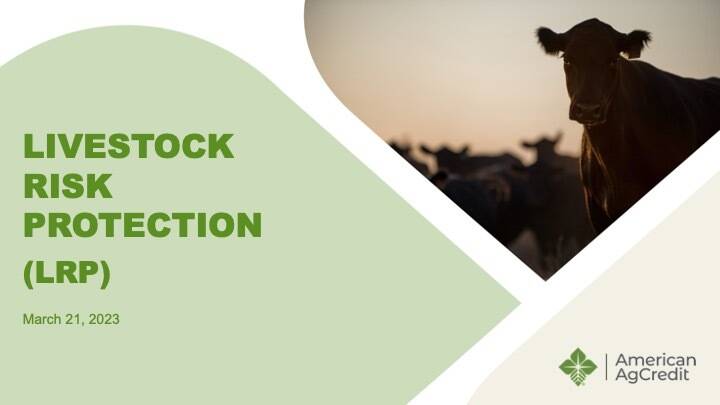Recognizing Livestock Threat Protection (LRP) Insurance Coverage: A Comprehensive Guide
Navigating the world of animals risk security (LRP) insurance policy can be an intricate venture for several in the farming industry. From just how LRP insurance coverage works to the numerous protection choices available, there is much to discover in this detailed overview that could potentially form the means livestock producers approach threat monitoring in their companies.

Just How LRP Insurance Policy Works
Sometimes, comprehending the mechanics of Animals Threat Security (LRP) insurance can be complicated, yet breaking down exactly how it functions can provide clarity for herdsmans and farmers. LRP insurance coverage is a danger monitoring tool made to shield livestock manufacturers versus unexpected cost decreases. The plan enables producers to establish a protection degree based upon their certain needs, picking the number of head, weight variety, and insurance coverage cost. Once the policy remains in location, if market value drop listed below the protection price, producers can sue for the difference. It is very important to note that LRP insurance policy is not an income warranty; instead, it concentrates only on price danger defense. The protection period generally varies from 13 to 52 weeks, providing versatility for producers to pick a duration that lines up with their manufacturing cycle. By making use of LRP insurance coverage, breeders and farmers can mitigate the financial dangers associated with changing market rates, making certain greater stability in their procedures.
Qualification and Protection Options

When it comes to coverage options, LRP insurance policy provides producers the adaptability to choose the coverage level, insurance coverage duration, and recommendations that finest suit their risk monitoring needs. By comprehending the eligibility requirements and protection options available, animals producers can make informed choices to handle danger properly.
Benefits And Drawbacks of LRP Insurance Coverage
When examining Animals Threat Defense (LRP) insurance, it is crucial for animals manufacturers to consider the advantages and downsides inherent in this threat monitoring tool.

Among the primary advantages of LRP insurance is its ability to give protection against a decrease in animals costs. This can assist guard manufacturers from economic losses resulting from market variations. Additionally, LRP insurance supplies a degree of flexibility, allowing manufacturers to customize insurance coverage levels and plan durations to match their specific requirements. By locking in an ensured rate for their livestock, producers can much better handle risk and prepare for the future.
Nevertheless, there are also some disadvantages to think about. One restriction of LRP insurance coverage is that it does not shield against all kinds of dangers, such as disease outbreaks or natural catastrophes. Costs can in some cases be costly, especially for producers with huge animals herds. It is vital for producers to very carefully analyze their private risk direct exposure and monetary scenario to determine if LRP insurance is the appropriate threat administration device for their procedure.
Comprehending LRP Insurance Premiums

Tips for Taking Full Advantage Of LRP Benefits
Taking full advantage of the benefits of Livestock Risk Defense (LRP) insurance coverage requires calculated planning and positive threat monitoring - Bagley Risk Management. To take advantage of your LRP protection, take into consideration the complying with tips:
On A Regular Basis Evaluate Market Problems: Keep notified regarding market trends and price variations in the livestock market. By checking these factors, you can make informed decisions regarding when to buy LRP insurance coverage to safeguard against possible losses.
Set Realistic Insurance Coverage Levels: When choosing coverage degrees, consider your production prices, market price of livestock, and potential threats - Bagley Risk Management. Setting practical protection degrees ensures my response that you are appropriately shielded without paying too much for unnecessary insurance coverage
Diversify Your Coverage: As opposed to relying exclusively on LRP insurance coverage, consider expanding your danger monitoring techniques. Combining LRP with other threat administration devices such as futures contracts or options can supply comprehensive coverage versus market unpredictabilities.
Evaluation and Readjust Coverage Frequently: go to my site As market problems change, regularly review your LRP insurance coverage to ensure it lines up with your existing danger direct exposure. Changing protection levels and timing of purchases can aid maximize your danger security approach. By adhering to these tips, you can make best use of the advantages of LRP insurance policy and secure your livestock operation versus unforeseen threats.
Verdict
In conclusion, livestock risk security (LRP) insurance is a beneficial tool for farmers to manage the monetary risks linked with their animals operations. By recognizing just how LRP functions, qualification and coverage alternatives, along with the advantages and disadvantages of this insurance, farmers can make educated decisions to protect their incomes. By carefully taking into consideration LRP premiums and applying methods to make best use of benefits, farmers can alleviate potential losses and make sure the sustainability of their operations.
Livestock manufacturers interested in getting Animals Risk Protection (LRP) insurance coverage can explore an array of qualification criteria and protection choices tailored to their specific livestock procedures.When it comes to protection choices, LRP insurance uses manufacturers the versatility to select the insurance coverage level, insurance coverage period, and endorsements that ideal fit their danger management needs.To comprehend the intricacies of Livestock Danger Security (LRP) insurance policy completely, recognizing the variables influencing LRP insurance coverage costs is critical. LRP insurance costs are see established by various aspects, including the insurance coverage level chosen, the anticipated price of animals at the end of the coverage period, the kind of livestock being insured, and the size of the coverage duration.Evaluation and Adjust Coverage Routinely: As market problems alter, occasionally assess your LRP insurance coverage to ensure it straightens with your current risk exposure.